Abstract
As socioeconomic status (SES) increases, the incidence of low birthweight and preterm birth decreases irrespective of social class. However, low birthweight remains twice as high for African-American women as for white women even when SES is controlled. This study examines to what extent second generation high SES African-American women experience improvement in birthweight and gestational age. One hundred eighty-nine former Meharry students were surveyed. Identified were 934 births that are the children and grandchildren of these students who matriculated at Meharry. These infants are compared with a cohort of white mothers from a study in the School of Public Health at Yale University. Low birthweight was reduced in the third generation high SES African-American children (6.9%) from the second generation (11.4%) but remained higher than white children (3.3%). Results showed that African-American third generation children remained at higher risk for low birthweight than were white children (relative risk [RR], 1.78; 95% confidence interval [CI], 1.03, 3.09). Similar results were observed for preterm delivery where the increased risk to third generation African-American children was 3.16 (1.89, 5.27). Persistent strong ethnic differences in birthweight in this high SES cohort (OR = 3.16, 95% CI, 1.89-5.27) support a conclusion that African-American women have birthweight distributions that are somewhat lighter than white women. This may explain a portion of current ethnic differences in birthweight. It is also possible that persistent psychosocial and behavioral factors continue to negatively influence birthweight, even in second generation high SES African-American mothers. This explanation will require identification of powerful risk factors, which are largely unrelated to those presently under investigation.
Full text
PDF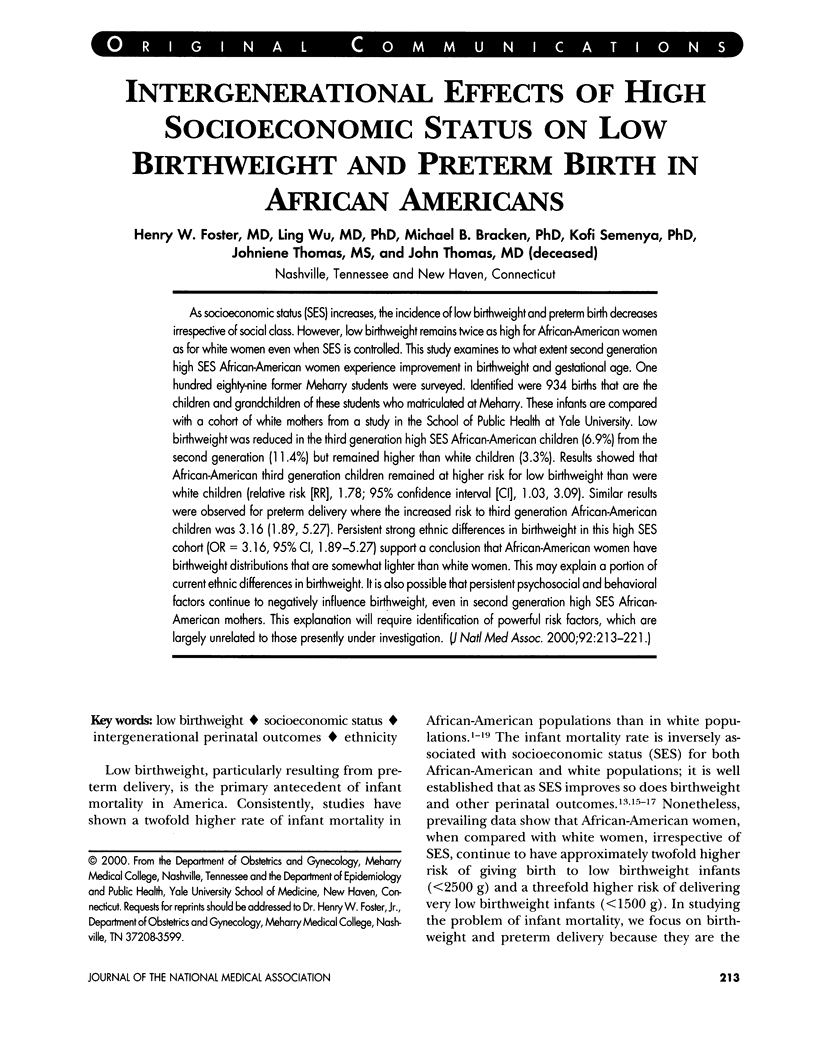


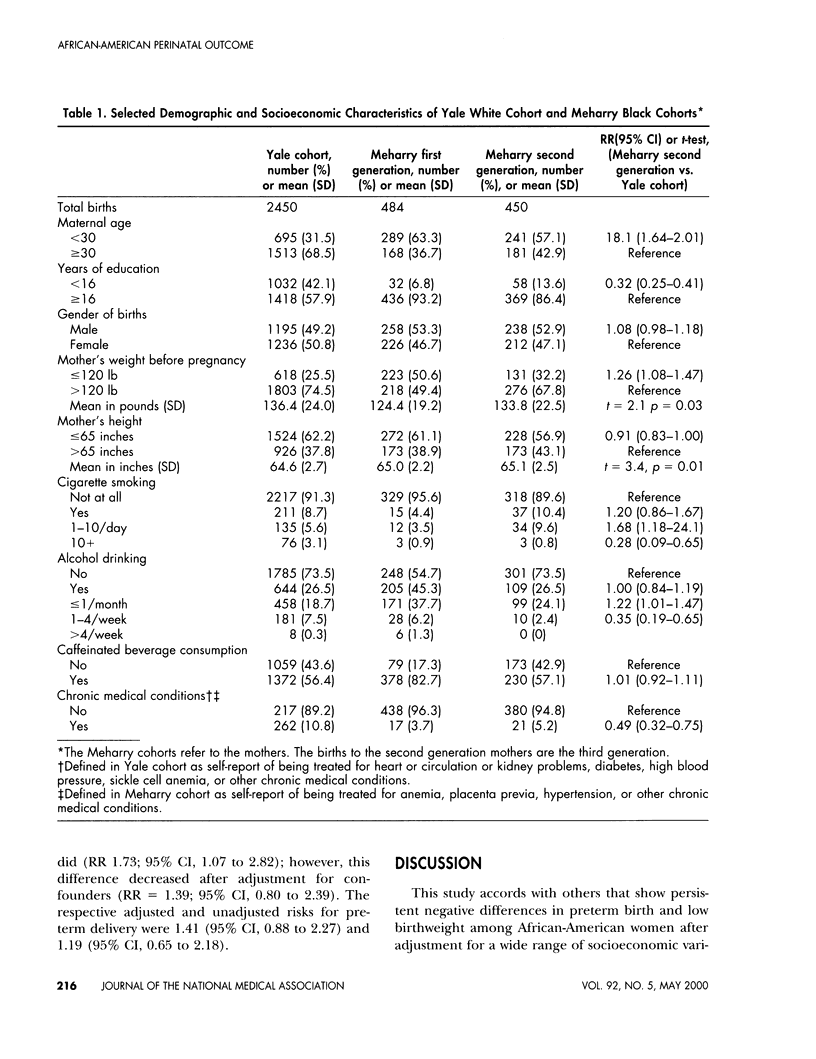
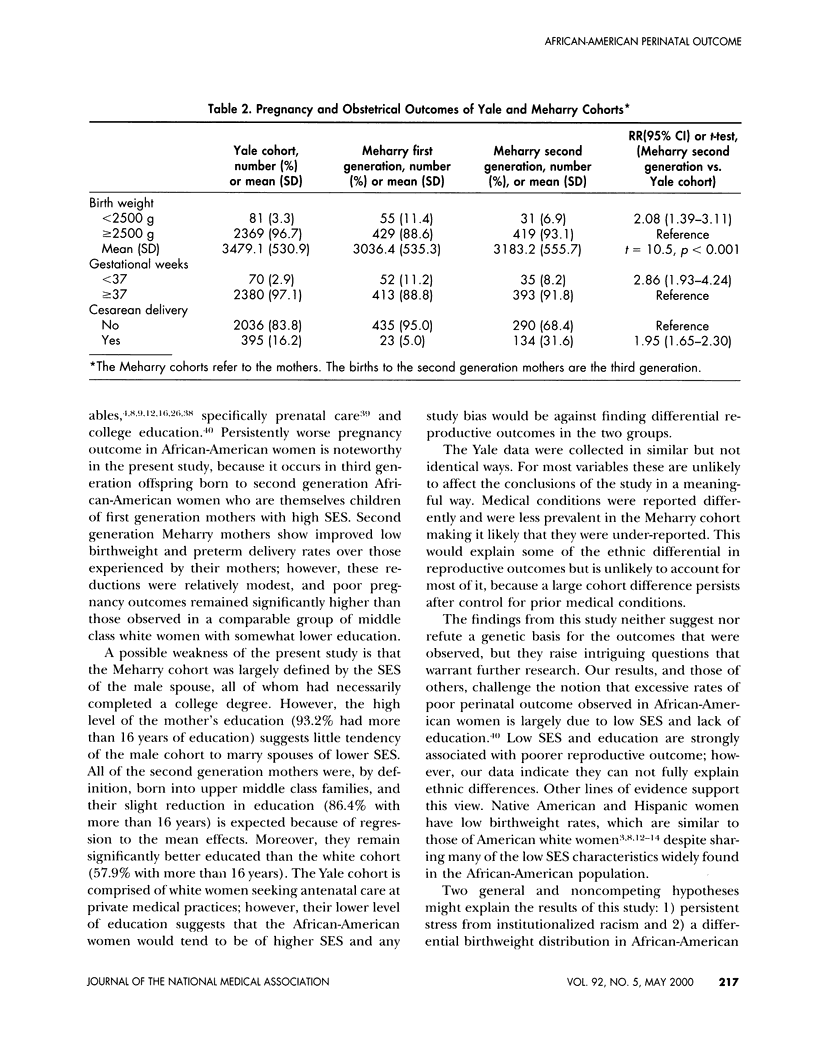
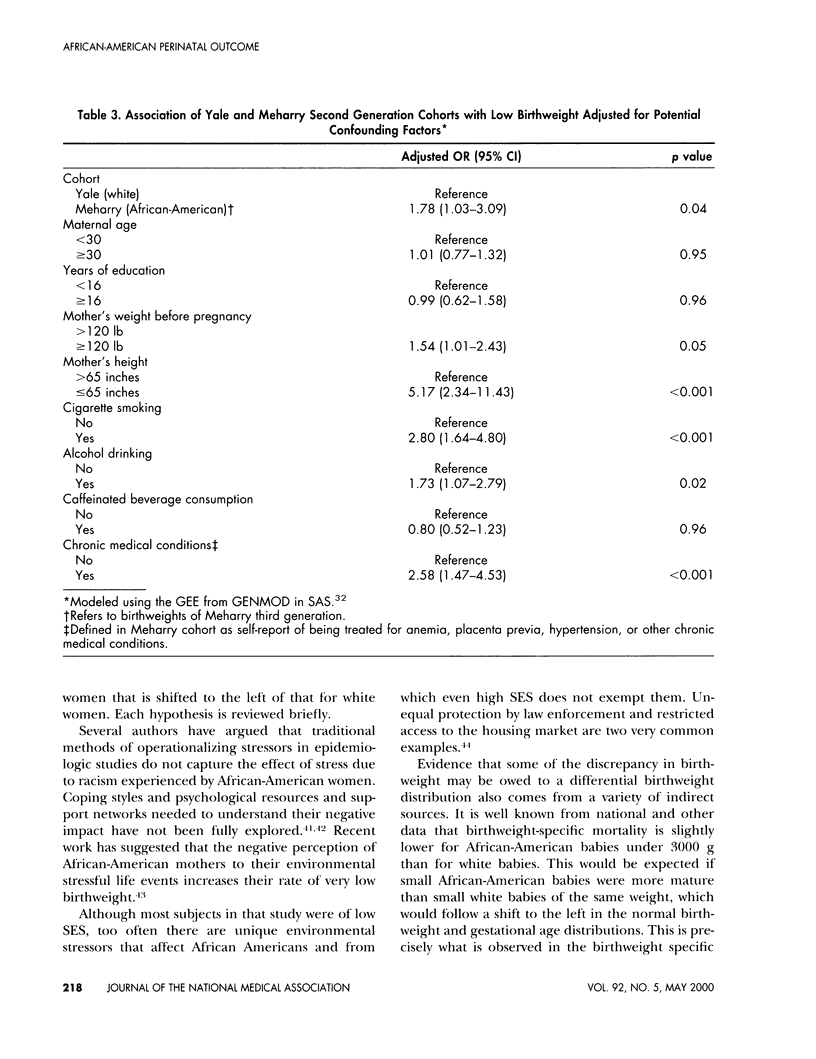
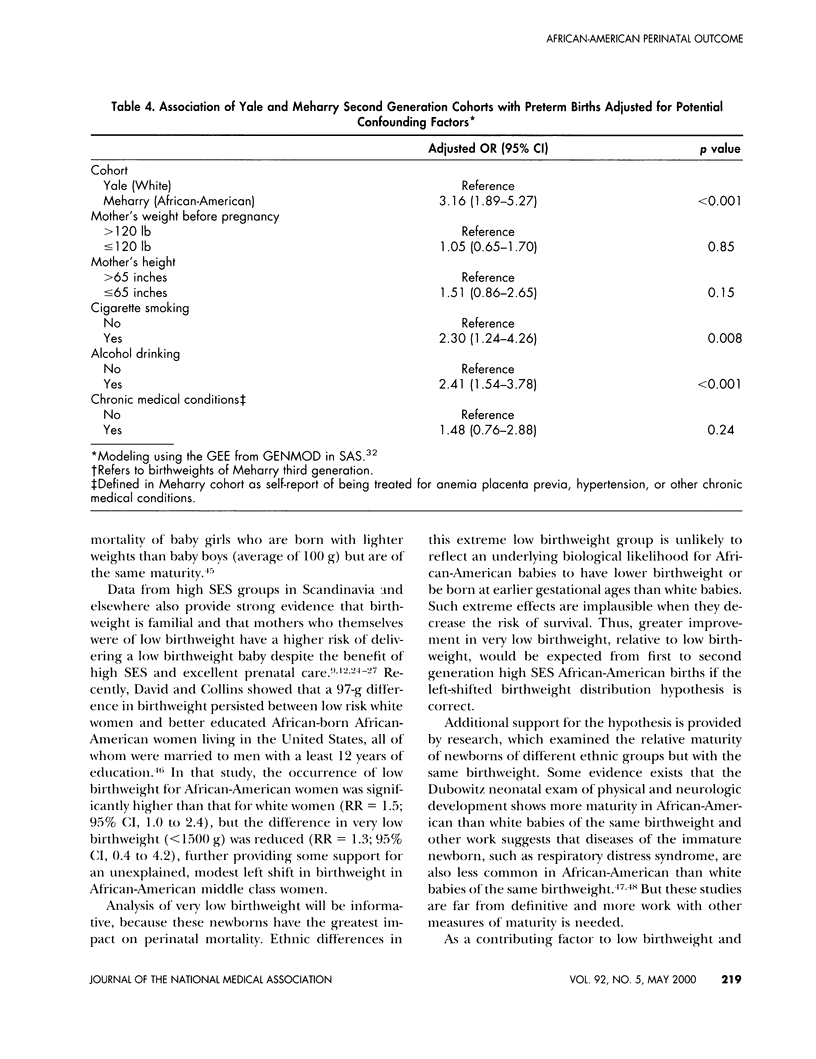
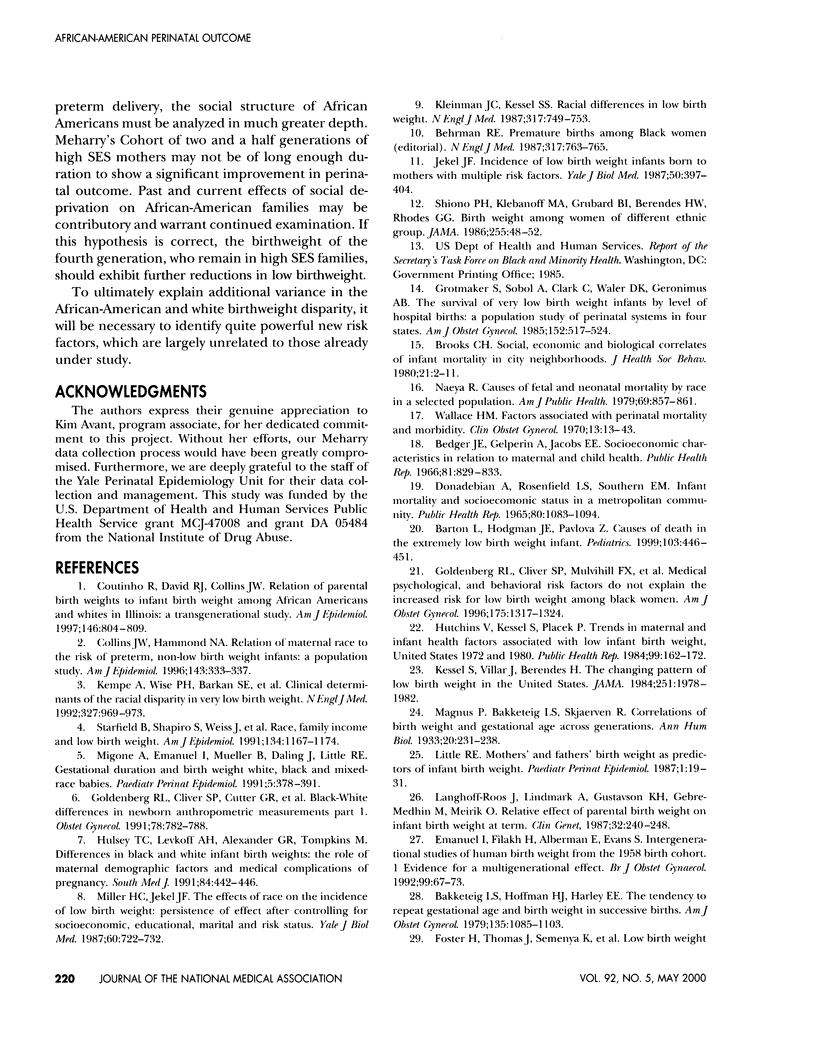
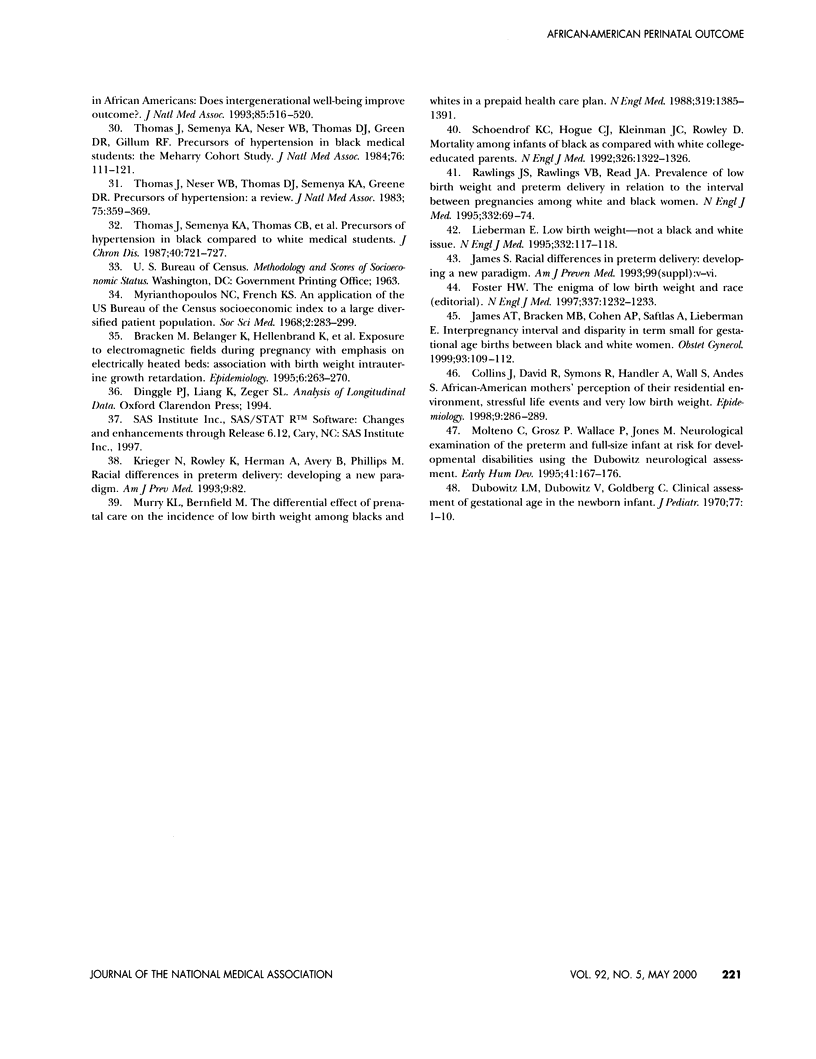
Selected References
These references are in PubMed. This may not be the complete list of references from this article.
- Bakketeig L. S., Hoffman H. J., Harley E. E. The tendency to repeat gestational age and birth weight in successive births. Am J Obstet Gynecol. 1979 Dec 15;135(8):1086–1103. doi: 10.1016/0002-9378(79)90742-7. [DOI] [PubMed] [Google Scholar]
- Barton L., Hodgman J. E., Pavlova Z. Causes of death in the extremely low birth weight infant. Pediatrics. 1999 Feb;103(2):446–451. doi: 10.1542/peds.103.2.446. [DOI] [PubMed] [Google Scholar]
- Bedger J. E., Gelperin A., Jacobs E. E. Socioeconomic characteristics in relation to maternal and child health. Public Health Rep. 1966 Sep;81(9):829–833. [PMC free article] [PubMed] [Google Scholar]
- Behrman R. E. Premature births among black women. N Engl J Med. 1987 Sep 17;317(12):763–765. doi: 10.1056/NEJM198709173171209. [DOI] [PubMed] [Google Scholar]
- Bracken M. B., Belanger K., Hellenbrand K., Dlugosz L., Holford T. R., McSharry J. E., Addesso K., Leaderer B. Exposure to electromagnetic fields during pregnancy with emphasis on electrically heated beds: association with birthweight and intrauterine growth retardation. Epidemiology. 1995 May;6(3):263–270. doi: 10.1097/00001648-199505000-00013. [DOI] [PubMed] [Google Scholar]
- Brooks C. H. Social, economic, and biologic correlates of infant mortality in city neighborhoods. J Health Soc Behav. 1980 Mar;21(1):2–11. [PubMed] [Google Scholar]
- Collins J. W., Jr, David R. J., Symons R., Handler A., Wall S., Andes S. African-American mothers' perception of their residential environment, stressful life events, and very low birthweight. Epidemiology. 1998 May;9(3):286–289. [PubMed] [Google Scholar]
- Collins J. W., Jr, Hammond N. A. Relation of maternal race to the risk of preterm, non-low birth weight infants: a population study. Am J Epidemiol. 1996 Feb 15;143(4):333–337. doi: 10.1093/oxfordjournals.aje.a008747. [DOI] [PubMed] [Google Scholar]
- Coutinho R., David R. J., Collins J. W., Jr Relation of parental birth weights to infant birth weight among African Americans and whites in Illinois: a transgenerational study. Am J Epidemiol. 1997 Nov 15;146(10):804–809. doi: 10.1093/oxfordjournals.aje.a009197. [DOI] [PubMed] [Google Scholar]
- Dubowitz L. M., Dubowitz V., Goldberg C. Clinical assessment of gestational age in the newborn infant. J Pediatr. 1970 Jul;77(1):1–10. doi: 10.1016/s0022-3476(70)80038-5. [DOI] [PubMed] [Google Scholar]
- Emanuel I., Filakti H., Alberman E., Evans S. J. Intergenerational studies of human birthweight from the 1958 birth cohort. 1. Evidence for a multigenerational effect. Br J Obstet Gynaecol. 1992 Jan;99(1):67–74. doi: 10.1111/j.1471-0528.1992.tb14396.x. [DOI] [PubMed] [Google Scholar]
- Foster H. W., Jr The enigma of low birth weight and race. N Engl J Med. 1997 Oct 23;337(17):1232–1233. doi: 10.1056/NEJM199710233371711. [DOI] [PubMed] [Google Scholar]
- Goldenberg R. L., Cliver S. P., Cutter G. R., Hoffman H. J., Cassady G., Davis R. O., Nelson K. G. Black-white differences in newborn anthropometric measurements. Obstet Gynecol. 1991 Nov;78(5 Pt 1):782–788. [PubMed] [Google Scholar]
- Goldenberg R. L., Cliver S. P., Mulvihill F. X., Hickey C. A., Hoffman H. J., Klerman L. V., Johnson M. J. Medical, psychosocial, and behavioral risk factors do not explain the increased risk for low birth weight among black women. Am J Obstet Gynecol. 1996 Nov;175(5):1317–1324. doi: 10.1016/s0002-9378(96)70048-0. [DOI] [PubMed] [Google Scholar]
- Gortmaker S., Sobol A., Clark C., Walker D. K., Geronimus A. The survival of very low-birth weight infants by level of hospital of birth: a population study of perinatal systems in four states. Am J Obstet Gynecol. 1985 Jul 1;152(5):517–524. doi: 10.1016/0002-9378(85)90618-0. [DOI] [PubMed] [Google Scholar]
- Hogue C. W., Jr, Ward J. M., Itani M. S., Martyn J. A. Tolerance and upregulation of acetylcholine receptors follow chronic infusion of d-tubocurarine. J Appl Physiol (1985) 1992 Apr;72(4):1326–1331. doi: 10.1152/jappl.1992.72.4.1326. [DOI] [PubMed] [Google Scholar]
- Hulsey T. C., Levkoff A. H., Alexander G. R., Tompkins M. Differences in black and white infant birth weights: the role of maternal demographic factors and medical complications of pregnancy. South Med J. 1991 Apr;84(4):443–446. doi: 10.1097/00007611-199104000-00008. [DOI] [PubMed] [Google Scholar]
- Hutchins V., Kessel S. S., Placek P. J. Trends in maternal and infant health factors associated with low infant birth weight, United States, 1972 and 1980. Public Health Rep. 1984 Mar-Apr;99(2):162–172. [PMC free article] [PubMed] [Google Scholar]
- James A. T., Bracken M. B., Cohen A. P., Saftlas A., Lieberman E. Interpregnancy interval and disparity in term small for gestational age births between black and white women. Obstet Gynecol. 1999 Jan;93(1):109–112. doi: 10.1016/s0029-7844(98)00404-9. [DOI] [PubMed] [Google Scholar]
- Kempe A., Wise P. H., Barkan S. E., Sappenfield W. M., Sachs B., Gortmaker S. L., Sobol A. M., First L. R., Pursley D., Rinehart H. Clinical determinants of the racial disparity in very low birth weight. N Engl J Med. 1992 Oct 1;327(14):969–973. doi: 10.1056/NEJM199210013271401. [DOI] [PubMed] [Google Scholar]
- Kessel S. S., Villar J., Berendes H. W., Nugent R. P. The changing pattern of low birth weight in the United States--1970 to 1980. JAMA. 1984 Apr 20;251(15):1978–1982. [PubMed] [Google Scholar]
- Kleinman J. C., Kessel S. S. Racial differences in low birth weight. Trends and risk factors. N Engl J Med. 1987 Sep 17;317(12):749–753. doi: 10.1056/NEJM198709173171207. [DOI] [PubMed] [Google Scholar]
- Krieger N., Rowley D. L., Herman A. A., Avery B., Phillips M. T. Racism, sexism, and social class: implications for studies of health, disease, and well-being. Am J Prev Med. 1993 Nov-Dec;9(6 Suppl):82–122. [PubMed] [Google Scholar]
- Langhoff-Roos J., Lindmark G., Gustavson K. H., Gebre-Medhin M., Meirik O. Relative effect of parental birth weight on infant birth weight at term. Clin Genet. 1987 Oct;32(4):240–248. doi: 10.1111/j.1399-0004.1987.tb03307.x. [DOI] [PubMed] [Google Scholar]
- Lieberman E. Low birth weight--not a black-and-white issue. N Engl J Med. 1995 Jan 12;332(2):117–118. doi: 10.1056/NEJM199501123320209. [DOI] [PubMed] [Google Scholar]
- Little R. E. Mother's and father's birthweight as predictors of infant birthweight. Paediatr Perinat Epidemiol. 1987 Apr;1(1):19–31. doi: 10.1111/j.1365-3016.1987.tb00084.x. [DOI] [PubMed] [Google Scholar]
- Migone A., Emanuel I., Mueller B., Daling J., Little R. E. Gestational duration and birthweight in white, black and mixed-race babies. Paediatr Perinat Epidemiol. 1991 Oct;5(4):378–391. doi: 10.1111/j.1365-3016.1991.tb00724.x. [DOI] [PubMed] [Google Scholar]
- Miller H. C., Jekel J. F. Incidence of low birth weight infants born to mothers with multiple risk factors. Yale J Biol Med. 1987 Sep-Oct;60(5):397–404. [PMC free article] [PubMed] [Google Scholar]
- Molteno C., Grosz P., Wallace P., Jones M. Neurological examination of the preterm and full-term infant at risk for developmental disabilities using the Dubowitz Neurological Assessment. Early Hum Dev. 1995 Apr 28;41(3):167–176. doi: 10.1016/0378-3782(95)01621-9. [DOI] [PubMed] [Google Scholar]
- Murray J. L., Bernfield M. The differential effect of prenatal care on the incidence of low birth weight among blacks and whites in a prepaid health care plan. N Engl J Med. 1988 Nov 24;319(21):1385–1391. doi: 10.1056/NEJM198811243192105. [DOI] [PubMed] [Google Scholar]
- Myrianthopoulos N. C., French K. S. An application of the U.S. Bureau of the Census socioeconomic index to a large, diversified patient population. Soc Sci Med. 1968 Sep;2(3):283–299. doi: 10.1016/0037-7856(68)90004-8. [DOI] [PubMed] [Google Scholar]
- Rawlings J. S., Rawlings V. B., Read J. A. Prevalence of low birth weight and preterm delivery in relation to the interval between pregnancies among white and black women. N Engl J Med. 1995 Jan 12;332(2):69–74. doi: 10.1056/NEJM199501123320201. [DOI] [PubMed] [Google Scholar]
- Shiono P. H., Klebanoff M. A., Graubard B. I., Berendes H. W., Rhoads G. G. Birth weight among women of different ethnic groups. JAMA. 1986 Jan 3;255(1):48–52. [PubMed] [Google Scholar]
- Starfield B., Shapiro S., Weiss J., Liang K. Y., Ra K., Paige D., Wang X. B. Race, family income, and low birth weight. Am J Epidemiol. 1991 Nov 15;134(10):1167–1174. doi: 10.1093/oxfordjournals.aje.a116020. [DOI] [PubMed] [Google Scholar]
- Thomas J., Neser W. B., Thomas J., Semenya K., Green D. R. Precursors of hypertension: a review. J Natl Med Assoc. 1983 Apr;75(4):359–369. [PMC free article] [PubMed] [Google Scholar]
- Thomas J., Semenya K., Neser W. B., Thomas D. J., Green D. R., Gillum R. F. Precursors of hypertension in black medical students: the Meharry cohort study. J Natl Med Assoc. 1984 Feb;76(2):111–121. [PMC free article] [PubMed] [Google Scholar]
- Thomas J., Semenya K., Thomas C. B., Thomas D. J., Neser W. B., Pearson T. A., Gillum R. F. Precursors of hypertension in black compared to white medical students. J Chronic Dis. 1987;40(7):721–727. doi: 10.1016/0021-9681(87)90109-3. [DOI] [PubMed] [Google Scholar]
- Wallace H. M. Factors associated with perinatal mortality and morbidity. Clin Obstet Gynecol. 1970 Mar;13(1):13–43. doi: 10.1097/00003081-197003000-00003. [DOI] [PubMed] [Google Scholar]


